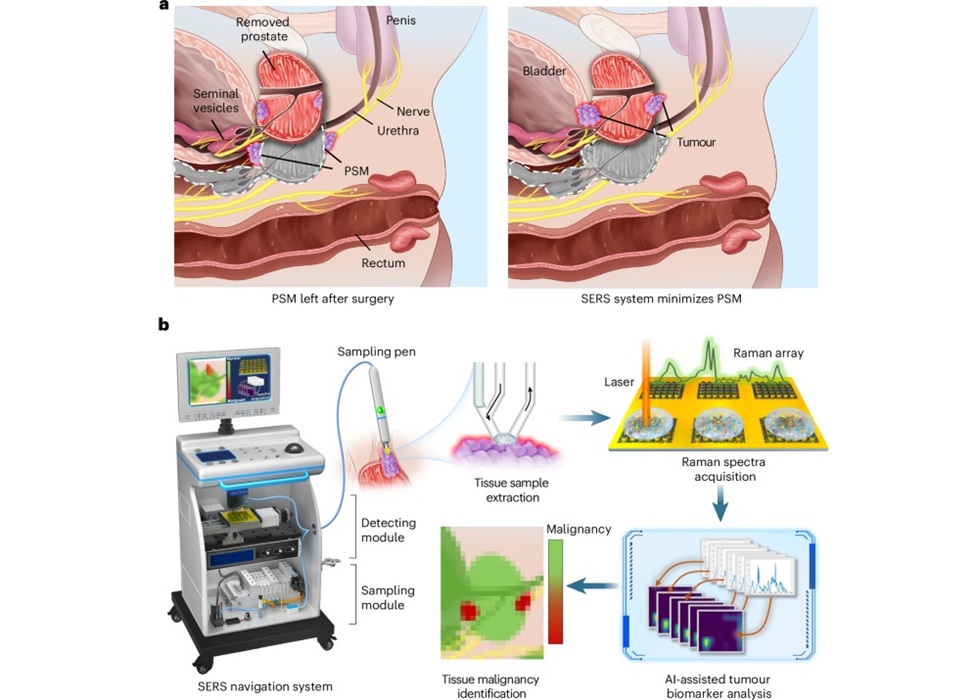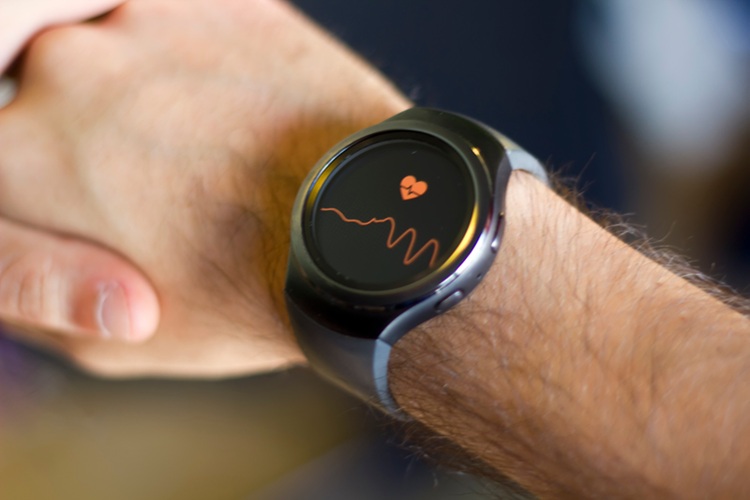Sensing Tool Measures Lung Function over the Phone
|
By HospiMedica International staff writers Posted on 12 May 2016 |
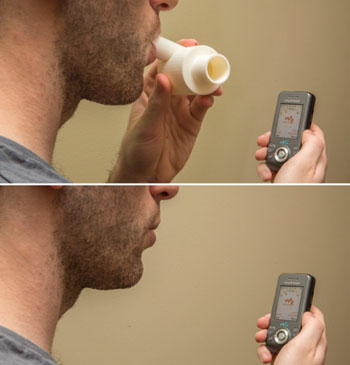
Image: A person using SpiroCall on a phone with and without a SpiroCall whistle (Photo courtesy of the University of Washington).
A new device allows lung function to be assessed from any phone, using the voice channel to transmit the sound of the spirometry effort.
Developed by researchers at the University of Washington (UW; Seattle, USA), the SpiroCall is a service that transmits an audio signal using the standard voice telephony channel. A server receives the data of degraded audio quality, calculates clinically relevant lung function measures using multiple regression algorithms, and reports the results using an audio message, text message, or both. The researchers also found several significant usability challenges more difficult to mitigate, such as how a user holds the phone, the distance from the user’s mouth to the phone, and how wide a user opens their mouth.
The researchers therefore designed a simple, low-cost 3D printed whistle accessory, which generates vortices as the user exhales through it, changing its resonating pitch in proportion to the flow rate. The whistle does not have any moving parts and is as simple as any spirometer mouthpiece. Advantages of the whistle include more consistent acoustic properties, audible sound at lower flow rates, removing the effect of distance from the user’s mouth, and precisely controlling mouth shape and phone orientation.
In a study to investigate viability of the call-in service approach with and without the whistle, the researchers evaluated SpiroCall in 50 patients, comparing it to approved spirometers and evaluating the effect of using the voice communication channel on performance. Each patient performed spirometry efforts with and without the whistle on two different phones, recording the audio through the cell phone network, and two smartphones recording the audio locally through an app. Participants also used two different sizes of vortex whistles to determine if different sizes work better for different individuals.
The results show that without a whistle, SpiroCall has a mean error of 7.2% for the four major clinically relevant lung function measures; for forced expiratory volume percentage (FEV1%), the mean error is 6.2%. With a whistle, SpiroCall has a mean error of 8.3% for the four measures, and 7.3% for FEV1%. Although the whistle shows higher average error in lung function estimates, it is more consistent for people with lower lung function and produces fewer overestimations. The study was presented at the Association for Computing Machinery conference, held during May 2016 in San Jose (CA, USA).
"People have to manage chronic lung diseases for their entire lives, so there's a real need to have a device that allows patients to accurately monitor their condition at home without having to constantly visit a medical clinic,” said lead author Mayank Goel, MSc, a computer science and engineering doctoral student. “Because this project has been around for four years, we've been able to talk to a lot of patients about how they're able to use the technology, and that feedback has really helped us make smart improvement.”
Related Links:
University of Washington
Developed by researchers at the University of Washington (UW; Seattle, USA), the SpiroCall is a service that transmits an audio signal using the standard voice telephony channel. A server receives the data of degraded audio quality, calculates clinically relevant lung function measures using multiple regression algorithms, and reports the results using an audio message, text message, or both. The researchers also found several significant usability challenges more difficult to mitigate, such as how a user holds the phone, the distance from the user’s mouth to the phone, and how wide a user opens their mouth.
The researchers therefore designed a simple, low-cost 3D printed whistle accessory, which generates vortices as the user exhales through it, changing its resonating pitch in proportion to the flow rate. The whistle does not have any moving parts and is as simple as any spirometer mouthpiece. Advantages of the whistle include more consistent acoustic properties, audible sound at lower flow rates, removing the effect of distance from the user’s mouth, and precisely controlling mouth shape and phone orientation.
In a study to investigate viability of the call-in service approach with and without the whistle, the researchers evaluated SpiroCall in 50 patients, comparing it to approved spirometers and evaluating the effect of using the voice communication channel on performance. Each patient performed spirometry efforts with and without the whistle on two different phones, recording the audio through the cell phone network, and two smartphones recording the audio locally through an app. Participants also used two different sizes of vortex whistles to determine if different sizes work better for different individuals.
The results show that without a whistle, SpiroCall has a mean error of 7.2% for the four major clinically relevant lung function measures; for forced expiratory volume percentage (FEV1%), the mean error is 6.2%. With a whistle, SpiroCall has a mean error of 8.3% for the four measures, and 7.3% for FEV1%. Although the whistle shows higher average error in lung function estimates, it is more consistent for people with lower lung function and produces fewer overestimations. The study was presented at the Association for Computing Machinery conference, held during May 2016 in San Jose (CA, USA).
"People have to manage chronic lung diseases for their entire lives, so there's a real need to have a device that allows patients to accurately monitor their condition at home without having to constantly visit a medical clinic,” said lead author Mayank Goel, MSc, a computer science and engineering doctoral student. “Because this project has been around for four years, we've been able to talk to a lot of patients about how they're able to use the technology, and that feedback has really helped us make smart improvement.”
Related Links:
University of Washington
Channels
Surgical Techniques
view channel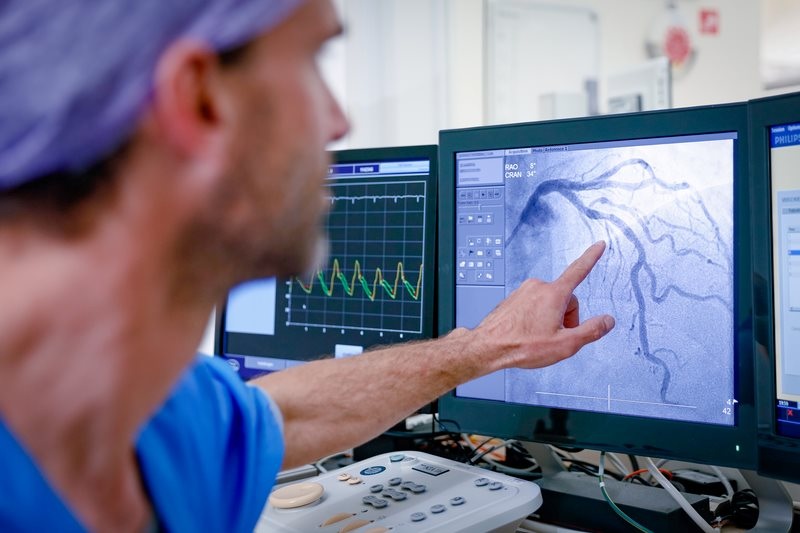
New Study Findings Could Halve Number of Stent Procedures
When a coronary artery becomes acutely blocked during a heart attack, opening it immediately is essential to prevent irreversible damage. However, many patients also have other narrowed vessels that appear... Read more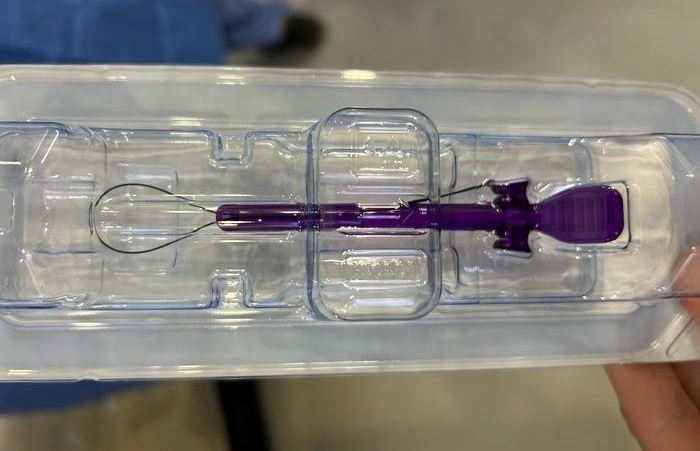
Breakthrough Surgical Device Redefines Hip Arthroscopy
Hip arthroscopy has surged in popularity, yet surgeons still face major mechanical constraints when navigating deep joint spaces through traditional cannulas. Limited tool mobility and the need for an... Read morePatient Care
view channel
Revolutionary Automatic IV-Line Flushing Device to Enhance Infusion Care
More than 80% of in-hospital patients receive intravenous (IV) therapy. Every dose of IV medicine delivered in a small volume (<250 mL) infusion bag should be followed by subsequent flushing to ensure... Read more
VR Training Tool Combats Contamination of Portable Medical Equipment
Healthcare-associated infections (HAIs) impact one in every 31 patients, cause nearly 100,000 deaths each year, and cost USD 28.4 billion in direct medical expenses. Notably, up to 75% of these infections... Read more
Portable Biosensor Platform to Reduce Hospital-Acquired Infections
Approximately 4 million patients in the European Union acquire healthcare-associated infections (HAIs) or nosocomial infections each year, with around 37,000 deaths directly resulting from these infections,... Read moreFirst-Of-Its-Kind Portable Germicidal Light Technology Disinfects High-Touch Clinical Surfaces in Seconds
Reducing healthcare-acquired infections (HAIs) remains a pressing issue within global healthcare systems. In the United States alone, 1.7 million patients contract HAIs annually, leading to approximately... Read moreHealth IT
view channel
EMR-Based Tool Predicts Graft Failure After Kidney Transplant
Kidney transplantation offers patients with end-stage kidney disease longer survival and better quality of life than dialysis, yet graft failure remains a major challenge. Although a successful transplant... Read more
Printable Molecule-Selective Nanoparticles Enable Mass Production of Wearable Biosensors
The future of medicine is likely to focus on the personalization of healthcare—understanding exactly what an individual requires and delivering the appropriate combination of nutrients, metabolites, and... Read moreBusiness
view channel
Philips and Masimo Partner to Advance Patient Monitoring Measurement Technologies
Royal Philips (Amsterdam, Netherlands) and Masimo (Irvine, California, USA) have renewed their multi-year strategic collaboration, combining Philips’ expertise in patient monitoring with Masimo’s noninvasive... Read more
B. Braun Acquires Digital Microsurgery Company True Digital Surgery
The high-end microsurgery market in neurosurgery, spine, and ENT is undergoing a significant transformation. Traditional analog microscopes are giving way to digital exoscopes, which provide improved visualization,... Read more
CMEF 2025 to Promote Holistic and High-Quality Development of Medical and Health Industry
The 92nd China International Medical Equipment Fair (CMEF 2025) Autumn Exhibition is scheduled to be held from September 26 to 29 at the China Import and Export Fair Complex (Canton Fair Complex) in Guangzhou.... Read more












